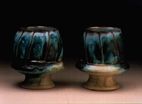









Two Exhibits of Functional Ceramics
The Society of Arts & Crafts, Boston | Forrest J. Snyder
It seems natural. Ask a child to draw her dream house, and you’re as likely to see a castle with mote, perhaps a star palace on mars, as you are a tract house with pool. Ask the same of her parents and more than likely you’ll see a carefully rendered plan of a suburban chalet complete with jacuzzi, 3-car garage, and rec room. Surprisingly, these roles of adventuresome fantasy versus staid practicality have reversed themselves with regards to these two exhibitions of functional ceramics.
These two shows, Functional Clay and Emerging Artists � Functional Clay, combined invited and juried artists. The established artists featured works by Jill Bonovitz, Malcolm Davis, Ann Gabhart, Lisa Horning-Cecere, Woody Hughes, Randy Johnston, Sandi Pierantozzi, Bonnie Seeman, Sandy Simon, Diana Thomas, and Todd Wahlstrom; they exhibited a wide range of work playing with the ideas of function, decoration, and utility. Included in the second exhibition, Emerging Artists, were Amy Evans, Steven Godfrey, Ayumi Horie, Alleghany Meadows, Ann Rainey, and Steven Roberts. In contrast to their more experienced elders, the emerging artists constructed, albeit competently, nothing more (or less) than the equivalent of solid, three bedroom, two and one half bath ranch homes. To be fair, it should be noted that none of the artists, established or emerging, exhibited work which was equivalent to the completely over-the-top eight bedroom, six bath, multi-turreted summer fantasy “cottage”. All of the works were unquestionably functional.
Among the established artists showing at The Society of Arts and Crafts’ Newbury Street Gallery, Bonnie Seeman produced the most elaborate work. Her pieces, cups, teapots, trays consisted of constructions of plant, flower, and vegetable parts. The petals and leaves show individual veins and wrinkles, giving the entire pieces living presence. To her credit, Ms. Seaman did not attempted to make each piece look like a single flower or lone head of cabbage. Each piece was a construction of distinct parts, be they vegetable or mineral. Indeed, Bonnie Seaman has mastered the art of tossing a delicious ceramic salad.
If Ms. Seeman is preparing the salad, Malcolm Davis produced the work on which the salad should be served. Mr. Davis has produced rare work; rare in it�s ability to transcend skin-deep beauty to reveal to the touch his understanding of what a function pot should be. Take one of his cups for example. The glaze - shino - breaks from tan to black in spectacular flash. One is compelled pick up the cup. This inviting, solid looking, vessel is surprisingly light. In this respect, the artist�s mastery of material is evident. Through glance or grasp, it is obvious that these works are meant to be used and enjoyed.
Of the artists exhibiting in either of these shows, Jill Bonovitz went the farthest in exploring the realm of function in a minimal, direct, form. In several ways, hers was the most adventurous work present, both in technique and decoration. She has developed a technique for producing exceedingly thin porcelain bowls, platters, and plates. The works are fragile and light. Functional? Yes. Utilitarian? No. Although one may be struck with the technique, it is one with direction towards a conclusive end. The strength of these pieces lay in their surface decoration. All together, they make this strength evident. Grouped by shape, over a dozen pieces hung on the wall. Each piece illustrated with a simple line drawing. These appearingly simple, child-like, images ranged from abstract “amoebas” and native American symbols to vaguely identifiable pea pods and peppers. What is hard to understand, but make this work stunning is the ability for these black lines drawn on thin translucent porcelain to transform their space and the space surrounding them.
In the Emerging Artist exhibition, Ann Rainey came closest to aligning her work to that of the established artists in the sense that her work showed some play and perhaps, just perhaps, a little abandonment. While all of her companions took a contempiraditional (contemporary with a slight twist on tradition) approach to thrown pottery, Ms. Rainey has chose to explore the world of slipcasting. The technique alone places her farther along the industrial to post-industrial road. However, it was her exploration of form beyond technique that causes pause. One may have noted similarities between her work and that of Jill Bonovitz in that both are of thin walled construction and employ abstracted decoration. To her advantage, Ann Rainey produced more practical work than while maintaining, indeed building, contemporary paths of function on which the user may trod.
In contrast to Ms. Rainey, Steven Roberts has chosen a completely different tack. He took well established tradition to the Nth degree. In doing so, Mr. Roberts went beyond, far beyond, mere replication. He has produced his own gorgeous tea bowls and cups that must be picked up. Mr. Roberts has nailed presentation with his sets of paired cups sitting on a thick mahogany shelves. The craftsmanship, the artists love and care for materials, was self-evident. The sensitive throwing marks through the selective glazing and firing witness Mr. Roberts� extraordinary dedication necessary to achieve this level of proficiency.
Allegheny Meadows immediately distinguished himself among either exhibition as the artist obviously using a variety of clay bodies. In the best sense, Mr. Meadows acts as the faithful follower of the traditions of utility laid down by the folk potters of the previous century. He produced a range of substantial, durable, bowls and cups. They are easy and usable, even though some of the forms have been manipulated to asymmetry while wet - a delicate dance when attempting to produce a vessel to hold food and drink. In it’s glazing and feel this work is straight forward. There is never a doubt as to whether these works will perform as promised.
While the established artists explored a range of size, from Randy Johnston’s large platters to Jill Bonovitz’ intimate bowls, the emerging artists stayed within very constrained size limitations. Not too big. Not too small. Each piece was clearly meant to be handled; that is set on the table, washed, and put in the cupboard ready for use. None of the pieces seemed to break outside of a 14” cube. In a word, the emerging artist work is conservative; conservative in the best possible sense.
To a one, each of the emerging artists identified themes of struggling to feel connected to our post-modern, post-industrial world. Among these six young artists, one senses a yearning for stability, community, and belonging. Each artist seeks reconnection to our world through their work, perhaps this is why the work is so solid and assured, the producers are not. Finally, one might venture to guess that just the opposite is true of the established artists. They are comfortable with who they are. They have determined their lot in life. Thus, these artists have the cognitive freedom to explore a wider range of more personal topics which resulted in a diverse and more adventuresome body of work. In either case, these groups of works are enjoyable and certain in their functionality.

Bonnie Seeman


Malcolm Davis


Jill Bonovitz


Ann Rainey


Steven Roberts


Allegheny Meadows
